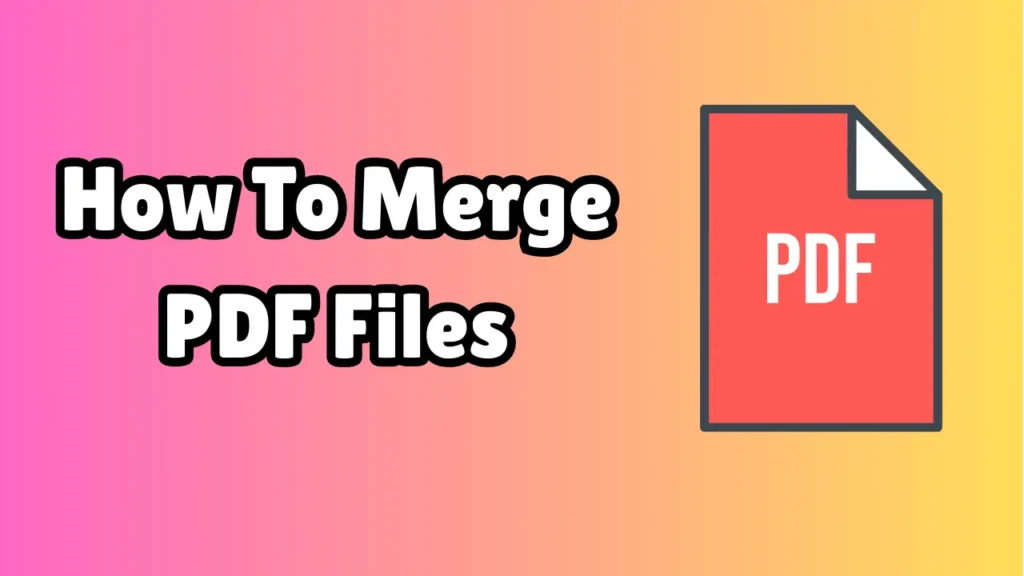How to Merge PDF Files
PDF (Portable Document Format) files are a standard for sharing documents across platforms and devices. Whether you’re a student combining assignments, a business professional assembling reports, or simply organizing documents, knowing how to merge PDF files is a useful skill. This article will guide you step-by-step on various methods to merge PDFs — online tools, offline software, and even command-line options for advanced users.

Why Merge PDF Files?
Before diving into the how-to, let’s quickly understand why you might want to merge PDF files:
-
Organization: Combine multiple documents into one file for easier reading and management.
-
Efficiency: Instead of sending many files via email, you can send one compact PDF.
-
Presentation: Create professional reports, e-books, or portfolios by compiling individual pages or chapters.
Method 1: Merge PDF Files Using Online Tools
One of the easiest ways to merge PDFs is by using online tools. These require no installation and work across all operating systems.
Popular Online Tools:
-
Smallpdf (www.smallpdf.com)
-
ILovePDF (www.ilovepdf.com)
-
PDF Merge (www.pdfmerge.com)
-
Adobe Acrobat Online (www.adobe.com/acrobat/online/merge-pdf.html)
Steps to Merge PDFs Online:
-
Visit a trusted PDF merger website.
-
Upload your PDF files. Most tools allow drag-and-drop functionality or upload from cloud storage (Google Drive, Dropbox).
-
Arrange the order of files as needed.
-
Click “Merge” or “Combine.”
-
Download the merged PDF to your device.
Pros:
-
No software installation
-
Easy to use
-
Works on any device
Cons:
-
File size limits (on free versions)
-
Security concerns when uploading sensitive documents
-
Requires internet connection
Method 2: Merge PDF Files Using Desktop Software
For frequent use or larger files, installing software on your computer can be a better option.
1. Adobe Acrobat Pro DC (Paid)
Steps:
-
Open Adobe Acrobat.
-
Go to Tools > Combine Files.
-
Click Add Files and select the PDFs.
-
Rearrange if needed.
-
Click Combine and save the file.
Pros:
-
High-quality output
-
Supports large files
-
Additional editing tools
Cons:
-
Subscription required
2. PDFsam Basic (Free and Open Source)
PDFsam (PDF Split and Merge) is a free, open-source tool available for Windows, macOS, and Linux.
Steps:
-
Download and install PDFsam from www.pdfsam.org.
-
Open the program and choose the Merge option.
-
Add the files, set order, and choose output location.
-
Click Run to merge.
Pros:
-
Free and offline
-
Open-source
-
No file limits
Cons:
-
Basic interface
-
Limited features compared to Adobe
3. Other Offline Tools:
-
Foxit PDF Editor
-
Nitro PDF Pro
-
PDF-XChange Editor
Method 3: Merge PDF Files on Mac (Preview App)
If you’re a Mac user, you don’t need any additional software. The built-in Preview app can merge PDF files quickly.
Steps:
-
Open the first PDF in Preview.
-
Go to View > Thumbnails to see pages.
-
Drag and drop the second PDF into the thumbnail pane where you want to insert it.
-
Go to File > Export as PDF or Save to keep the changes.
Pros:
-
Built-in tool
-
Fast and reliable
Cons:
-
Limited to macOS
-
Doesn’t support advanced editing
Method 4: Merge PDF Files on Windows Using Microsoft Print to PDF
Windows doesn’t have a built-in PDF editor, but you can use the “Print to PDF” function as a workaround.
Steps:
-
Open all the PDFs in a viewer (like Edge or Chrome).
-
Print each one using the “Microsoft Print to PDF” option.
-
Select all pages in desired order.
-
Combine into one PDF by printing them to the same file.
Note: This method is not ideal for large documents or precise control over layout.
Method 5: Merge PDF Files Using Command Line (Advanced Users)
If you’re comfortable using the command line, tools like PDFtk, Ghostscript, or PDFMerger (Python) can automate merging.
Example using PDFtk:
Command:
pdftk file1.pdf file2.pdf cat output merged.pdf
Pros:
-
Automation
-
Lightweight
-
Ideal for batch operations
Cons:
-
Learning curve
-
Requires installation and setup
Tips for Merging PDFs Effectively
-
Check the page order before merging to ensure the final document flows correctly.
-
Compress the final PDF if the size becomes too large, especially when sending via email.
-
Use file naming conventions to keep track of originals and merged versions.
-
Be cautious with confidential documents — avoid uploading them to online tools unless they are encrypted or you trust the provider.
Common Issues and How to Fix Them
| Issue | Solution |
|---|---|
| Merged file is too large | Use a PDF compressor tool |
| Pages are in wrong order | Rearrange before merging |
| Corrupted file error | Open each file separately to check for damage before merging |
| Can’t merge password-protected PDFs | Remove passwords first using tools like Smallpdf or Adobe Acrobat |
Conclusion
Merging PDF files is a straightforward process once you know the right tools and steps. Whether you prefer online convenience, desktop power, or command-line precision, there’s a method that suits your needs.
For occasional users, online tools like Smallpdf or ILovePDF are great. For frequent tasks, desktop tools like Adobe Acrobat or PDFsam offer robust functionality. Mac users can rely on Preview, while tech-savvy users can automate tasks with command-line utilities.
By mastering this skill, you’ll save time, stay organized, and create professional-looking documents with ease.